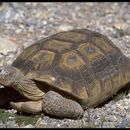Biology
provided by Arkive
Desert tortoises reach sexual maturity when they attain a size of roughly 20 centimetres, which may take up to 15 years (3). Mating begins in early spring; male courtship involves head bobbing and nipping the female's carapace and legs (2). Males also compete amongst each other at this time, using their gular horn they attempt to overturn their component or to chase them away (2). Females construct nests in the desert sand, burying their clutch of around 5 eggs (3). The temperature of the developing eggs determines the sex of the hatchlings; females develop at higher temperatures (3). Hatchlings emerge 90 – 135 days after laying, but the mortality rate of both eggs and hatchlings is very high (2).
These tortoises graze on desert grasses, obtaining almost all of the water they require from their food (2). Rocks and soil are also ingested, possibly as a means of obtaining minerals (2). As cold-blooded animals, tortoises adopt behavioural means of regulating their temperature; they hibernate in burrows during the winter months and are also dormant through the hottest part of summer in a behaviour known as aestivation (2). In some areas, extensive burrow systems are constructed and these may be shared by a number of tortoises (2).
Conservation
provided by Arkive
The desert tortoise is listed as Threatened on the U.S. Endangered Species Act and is protected throughout its range. The U.S. Fish & Wildlife Service has published a Recovery Plan for the species that recommends managing areas of suitable habitat for tortoise conservation (7). The Desert Tortoise Council was established in 1976 and is working to promote the conservation of this rare tortoise (8).
Description
provided by Arkive
This medium-sized tortoise inhabits the deserts of the western USA. The carapace varies in colour from light brown to dark with orange or yellowish markings (3). The front of the under shell (or plastron) is extended in a projection known as the 'gular horn', which is particularly pronounced in adult males (3). Males are also distinguished by having longer tails and a raised area to the rear of the plastron (4).
Habitat
provided by Arkive
The desert tortoise occurs in a variety of different habitats within the Mohave and Sonoran Deserts, from sandy flats to rocky foothills, river valleys and canyons (2).
Range
provided by Arkive
Endemic to the southwestern United States and Mexico. This tortoise is recorded from southeastern California, southern Nevada, southwestern Utah and Arizona. In Mexico, it is found from Sonora to northern Sinaloa and the cape of Baja California (5).
Status
provided by Arkive
Classified as Vulnerable (VU – A1acde+2cde, E) on the IUCN Red List 2002 (1).
Threats
provided by Arkive
The population of desert tortoises has declined throughout their range, habitat has been degraded by development, mining and the grazing of livestock (4). In addition, these tortoises are collected for the illegal pet trade and are at risk from desert vehicles (6).

